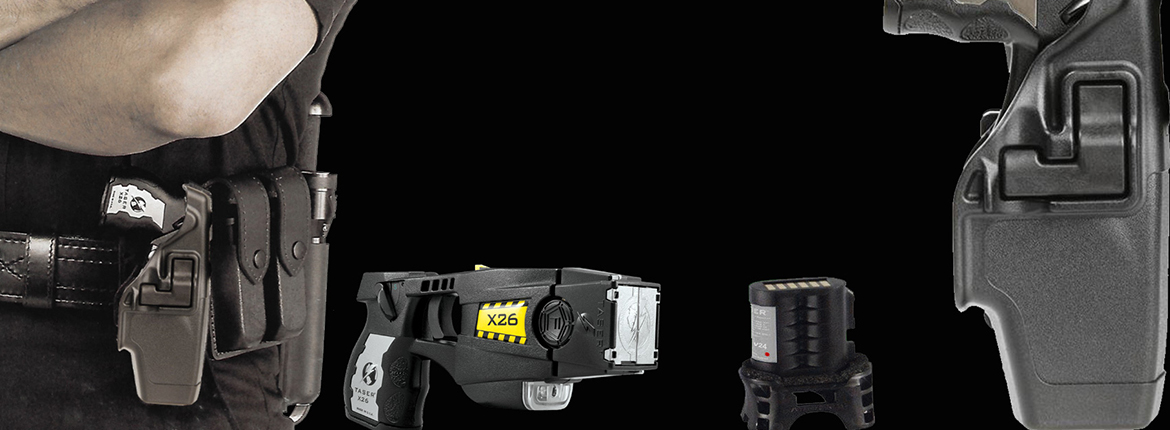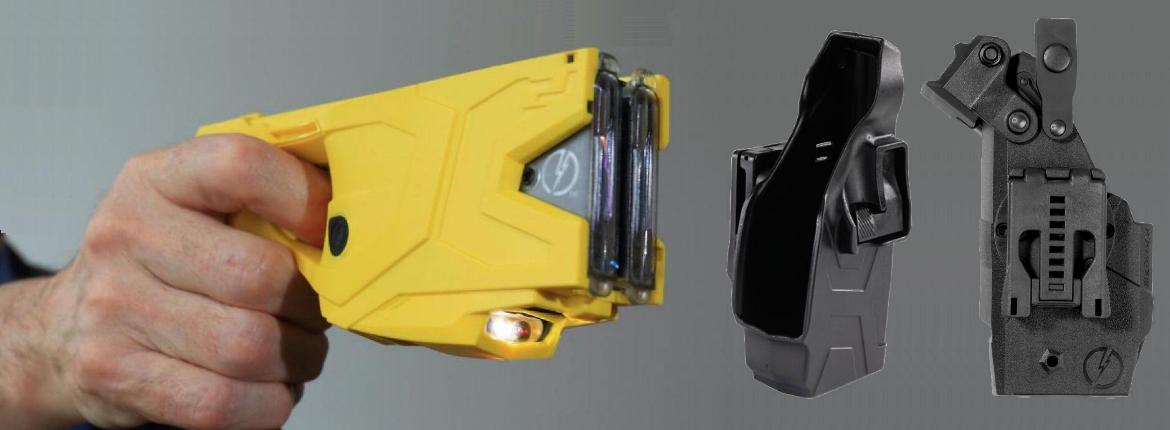Call 1-800-352-5294 Now to order by phone. Order Online 24 Hours a Day.
TASER® Instructions
Instructions and Possible Damages Involved in TASER Use
TASER® weapons fire very accurately from a safe distance of several feet away with the use of barbed
projectiles (probes) connected by insulated wire to the TASER. Unlike ordinary stun guns, all TASER weapons
utilize Electro-Muscular Disruption (EMD) stopping power that incapacitates by subjecting the body to a patented
series of rapid pulses of electrical current that are specifically timed to interrupt the human electro-muscular
system. The subject loses mobility through the inability to control their arms and legs, and fall to the ground.
Although they maintain consciousness, they become disoriented and usually remain immobile for some time
afterward.
Use your TASER only in self defense. Do not "test" it on someone else. In 2009 an Air Force study found that
repeated shocks from a TASER stun gun led to heart damage in pigs. Specifically, the study examined the pigs'
blood and found a jump in the enzyme Troponin T. It also found the pigs suffering high levels of blood acid, a
potentially life threatening condition called acidosis. It should be noted the pigs in this study were shocked
18 times, when most people are hit once, and none of the pigs died. Between 1999 and 2009, there have been 86
deaths connected to the TASER and one-third of the deaths came from some kind of heart failure. The
manufacturer, TASER International has never been blamed as the leading cause. TASER International released a
statement calling the Air Force's 18 shocks "extreme" and claiming the blood tests are similar to what "would be
expected (from) strong physical exertion." TASER International also notes that the Air Force's researcher called
his discovery of the Troponin T heart enzyme statistically insignificant, and has always said multiple TASER
shocks make no difference. Now there is some evidence that multiple shocks may cause damage. The American
Academy of Emergency Medicine (AAEM) advises a maximum exposure to conductive electronic weapons (CEW) of no
more than 15 seconds per 24 hours.
Inspect the safety mechanism and the trigger mechanism. On the AIR TASER and TASER C2 the safety mechanism is on
the top, and the trigger is a button also located on the top. On all the TASER M18, M26 and X26 models the
safety is a lever on both sides with a conventional trigger. For that reason the M18, M26 and X26 models are
very instinctive and easy to use. If your TASER is equipped with a lasersight, the lasersight turns on when you
activate the safety. The lasersight is an effective deterrent. Aim the lasersight high on the body. The first
probe (barbed projectile) and wire will strike there. The second probe will land a few inches below.
To test your TASER remove the cartridge by squeezing both sides and pulling it out away from the TASER. You can
now release the safety to turn it on and activate the trigger. You will see and hear sparks as they arc across
the front of the TASER. You can then turn the safety back to the "safe" position in order to conserve your
battery. That is the proper way to test your TASER without sacrificing a cartridge. If you see and hear the
sparks, you know your TASER is functioning properly. You may want to test your TASER once a month.
Batteries are provided. If you fail to see a spark or the spark is weak, replace the batteries. The batteries
are located in the handgrip of the M18 and M26. Use a ballpoint pen to remove the cover and then slide out the
battery holder. Make sure the contacts are clean and replace them with AA alkaline batteries. Make sure all the
batteries are facing the correct way, and carefully slide the battery holder into the handgrip so the contacts
match up properly. The AIR TASER takes a 9 Volt alkaline battery in the handle. Make sure to install it with the
positive (+) side up. The TASER C2 and TASER X26 models use proprietary DPM Digital Power Modules which you can
purchase from us. Fully depress the button in the side of the hand grip to remove the DPM battery. Batteries and
DPMs typically last several years before they need replacing.
When firing your TASER hold your TASER upright. The top probe and wire will land where you aim as indicated by
the lasersight (if your TASER is equipped with one), and the second probe and wire will land a few inches below.
Both probes must hit the subject in order to work. The probes are effective even through clothing an inch thick.
Always make sure you are no more than 15 feet away from your subject. However, this is a close range weapon. It
is best to be no more than 10 feet away from the subject because the further away you are, the further apart the
probes will hit. Even law enforcement officers equipped with 21' and 25' cartridges are trained to fire at a
range of no more than 10 feet whenever possible.
Never test your TASER by firing at another individual regardless of whether they give you permission. Use your
TASER only for self defense. Avoid targeting the face, head, groin and the frontal chest area near the heart
whenever possible to reduce the risk of potential serious injury or death. If you have an extra cartridge you
wish to use for practice, you can attach a three foot length of aluminum foil onto a wall and fire at that.
Each cartridge will fire only once. If you have a second cartridge, you can reload quickly and fire again, or
you can continue to use your TASER on contact as an ordinary stun gun. To use your TASER as an ordinary stun gun
you must hold it hard against the body, preferrably against the skin and continue to hold it there as you
activate the trigger. You can do this to defend yourself against a second attacker even without removing the
spent cartridge. If the first attacker is still be connected to your TASER by the wires, they will also be
affected by the EMD current.
What differentiates the X26 law enforcement (LE) version from the civilian X26C version of the TASER is the
duration of the electrical discharge. Officers are expected and trained to take criminals into custody.
Therefore the LE current discharge lasts only 5 seconds as that is approximately the time it takes for a law
enforcement officer to handcuff and arrest a subject. The civilian X26C version of the TASER provides 10 seconds
of current, and the trigger on the X26C can be pulled twice more to create a 30-second cycle. When used in self
defense, you can set the TASER down and flee to a position of safety where you can call your local law
enforcement agency. If you utilize your civilian TASER in self defense, and it is either left at the scene or
taken as evidence by the police, you can provide a copy of the police report to the manufacturer documenting
your loss. Depending on the circumstances and their policy at the time, they may replace your TASER free of
charge.
The TASER X26C was modeled after the law enforcement TASER X26, and utilizes the same proven technology. One
trigger pull of the X26C initiates a 10-second cycle, while the LE law enforcement model runs for 5 seconds.
Moreover, the trigger on the X26C can be pulled several times to create a 30-second cycle. The user can then
deploy the X26C, quickly squeeze the trigger 2 additional times to create a 30-second cycle (3 pulls x 10
seconds = 30 seconds), place the X26C on the ground, and depart the scene - while the X26C safely disables the
assailant. The law enforcement version cannot be triggered multiple times to create back-to-back cycles. However
the LE version can function again for 5 seconds by pulling the trigger again immediately after. Cycle times on
both models may be interrupted by placing the safety lever in the "safe" position. Per second, the LE X26
delivers 19 pulses of electricity into the target. Since the X26C is capable of delivering a much longer cycle,
these pulses range from 19 per second for the first 5 seconds, then drop down to 10 pulses per second for any
remaining time.
The range is not determined by the weapon itself, but rather by the cartridge. The yellow-tipped civilian air
cartridges have a 15-foot range, while law enforcement officers have access to cartridges with ranges of 21'
(gray) and 25' (green) in range. Finally, the X26 LE model records time and date for each deployment. This
feature helps protect law enforcement agencies from claims of excessive use-of-force, and also provides
management a powerful tool to track usage patterns and prevent misuse. The firing data on the X26C is not
recorded, and cannot be downloaded.
Avoid targeting the face, head, groin and the frontal chest area near the heart. The manufacturer's warning in
its training materials states: "When possible, avoid targeting the frontal chest area near the heart to reduce
the risk of potential serious injury or death. "Serious complications could also arise in those with impaired
heart function or in those with an implanted cardiac pacemaker or defibrillator." Firing at the back is the
preferred option where practical.
The Scottsdale, Arizona-based manufacturer of the 50,000-volt stun guns used by departments across the country
suggests police should avoid shooting suspects in the chest. TASER International Vice President of Training Rick
Guilbault said in an October 12, 2012 bulletin the decision was based on best practices research and will help
police avoid lawsuits from those who claim the devices cause injuries and other health problems.
The bulletin states that the risk of someone going into cardiac arrest when a TASER is deployed on them is low,
but notes people's reactions can't be predicted, particularly when other underlying medical conditions or drugs
are added to the equation. "We have not stated that TASER causes [cardiac] events in this bulletin, only that
the refined target zones avoid any potential controversy on this topic," Steve Tuttle, vice president of
communications for TASER, said in a prepared statement.
TASER officials say lowering of a TASER from the chest will incapacitate someone more effectively. The bulletin
notes police can still shoot a suspect's chest if there isn't a better option. Police are also trained to aim
away the face, head and groin. Officers were originally taught to aim for "center mass." The chest and the back
are the two largest target areas you have to aim for, so encouraging officers to avoid shooting at the chest is
a departure from what most officers were originally trained to aim for.
These instructions are provided to meet the California State law requirement of providing an "Instruction
Booklet" and Pennsylvania state law requiring "clearly written instructions as to its use and the damages
involved in its use" and to meet all other state and local laws requiring instruction and other information.
Accredited Security is a Division of Accredited Financial Services, a Nevada Corporation. Accredited Financial
Services has been a Member of the Southern Nevada Better Business Bureau since 2006. TASER® is a Trademark
of the Manufacturer TASER International, Inc. Accredited Security does not offer a warranty** on TASER CEWs
through TASER International, Inc., nor is warranty** on a purchased and refurbished*** TASER CEW offered or honored
by TASER International, Inc. Accredited Security is not affiliated with the manufacturer TASER International,
Inc. Accredited Safety™, Accredited Security™, MisterStungun® and MrStungun® are Trademarks
of Accredited Financial Services, LLC.







